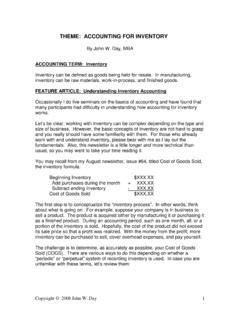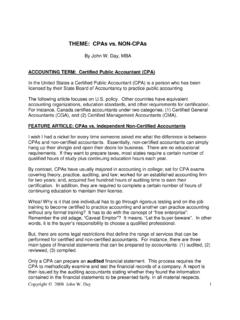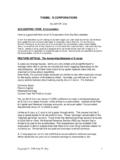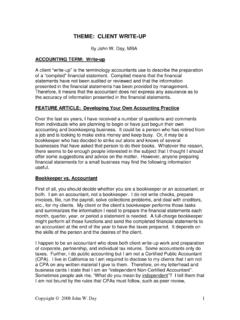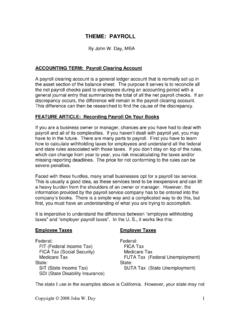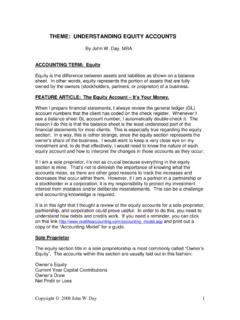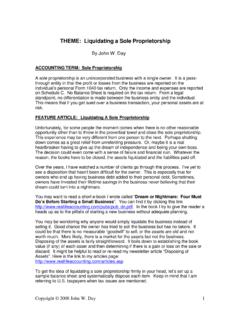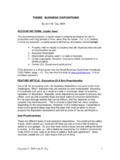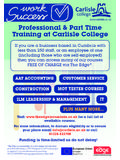Transcription of RLA Article Startng or Buying A New Business
1 Copyright 2008 John W. Day 1 THEME: STARTING OR Buying A NEW Business By John W. Day, MBA accounting TERM: Amortization Amortization is the process of spreading the cost of intangible assets over a uniform period of time. For example, if the cost of an intangible asset was $1,000 and the period of time was five years or sixty months, then by dividing $1,000 by 60, the result is a monthly amortization cost of $ FEATURE Article : Setting Up The Beginning Balance Sheet Setting up your books properly at the very beginning will go a long way in keeping you out of trouble later on. When you start, or buy, a new Business there is a lot more to it than just selling your goods or services, and writing checks for your expenses. First, you must decide what type of Business entity best fits your needs.
2 Will it be a sole proprietorship, partnership, C or S corporation, or perhaps even a non-profit organization? Knowing this will help you decide what type of bookkeeping system is required. Although similar, each type of Business entity has certain accounts that are unique to it. Therefore, from an accounting standpoint, your first order of Business will be to set up a Chart of Accounts that includes all the general ledger accounts you are going to use. Next, you will need to make a list of all the transactions that have occurred before you opened your doors for Business . Once you have done this, then you will translate those events into accounting transactions that are recorded in your General Journal. Let s think about a typical situation for someone who is starting his/her Business either from the ground up or through a purchase.
3 The size and scope of the new Business will determine whether certain costs will occur. For example, if it is decided that the Business should be incorporated, then there will probably be costs for lawyers and accountants, incorporation fees to the state, and board of directors meeting expenses. These are called Organizational Expenses and have to be treated as capital expenditures as opposed to current operational expenses. If the Business requires employees, there may be training costs. There could be investigative costs, including: analysis of potential markets; facilities; labor force; financial projections; etc. There also could be costs for advertising the Business opening, or travel to the opening. In addition, there might be consulting fees or other professional fees for advice regarding the structure of the new Business .
4 Copyright 2008 John W. Day 2 These types of expenses are called, Business Start-Up Costs and also have to be treated as capital expenditures. If you are Buying a Business , the purchase might include a covenant not to compete , copyrights or patents, a franchise, trademark, or trade names. It could also include a customer list, or contracts with customers, or perhaps specialized computer software not available to the general public. These items are called Identifiable Intangible Assets and are considered capital expenditures. Another common intangible asset that can come with the purchase of another Business is called Goodwill . Goodwill is the ability of a Business enterprise to earn a rate of return on net assets (owner s investment) in excess of a normal rate for the industry in which the Business enterprise operates.
5 In other words, Goodwill is the difference between the value of a Business enterprise as a whole and the sum of the current fair values of its identifiable tangible and intangible net assets. Think of it like this: You buy a Business for $50,000. You know that the fair value of all the equipment, inventory and patents is $40,000. The remaining difference of $10,000 is considered to be Goodwill. Since there may be a variety of reasons why this Goodwill exists, Goodwill is considered to be an Unidentifiable Intangible Asset . Goodwill is a capital expenditure as opposed to a current operating expense. Then, there are the tangible assets that one might purchase brand new or that are part of an existing Business . Tangible assets are said to be items you can stub your toe on , such as equipment, furniture and fixtures, buildings, land, inventory, etc.
6 Tangible assets are capital expenditures that are expensed, depending on their nature, via depreciation or cost of goods sold. So you can see you have a job to do to set up your books properly. You have acquired all these assets, but another question to be answered is: Where did the money come from to purchase them? Did it come from your personal savings account? Did you borrow the money? Or, did you do some of both? Here is an example of what your starting journal entry might look like: DESCRIPTION DEBIT CREDIT Cash 50,000 Common Stock 25,000 Notes Payable 25,000 This journal entry records where the money came from. It is wise to deposit the initial money into the Business bank account first, and then buy the assets so there is a good audit trail of what transpired.
7 The next journal entry example shows how to record the acquisition costs of the purchase: Copyright 2008 John W. Day 3 DESCRIPTION DEBIT CREDIT Inventory 5,000 Equipment 12,000 Furniture & Fixtures 3,000 Start-Up Costs 5,000 Organizational Costs 3,000 Patent 5,000 Franchise Fee 7,000 Goodwill 10,000 Cash 50,000 To record acquisition costs These are the steps required to establish your beginning Balance Sheet. Now you are ready to begin recording the current operating revenue and expenses of your new Business . QUESTION: Can Start-Up Costs, Organizational Expenses, and Intangible Assets Be Written Off? The answer to this question is, yes, but how they are written off depends on whether you are working under Generally Accepted accounting Principles (GAAP) or United States tax law.
8 If you live outside the it would be wise to check on the rules pertaining to your own country. Most small businesses follow tax law when determining the length of time to amortize Start-Up (Preoperating) Costs, Organizational Expenses, and Intangible Assets. They do this because, to do otherwise, would require preparation of another set of financial statements. GAAP rules generally allow for amortization of no more than forty years unless you can establish a basis for a shorter term. Therefore, let s focus on the tax law. Start-Up Costs and Organizational Expenses can be amortized over a minimum period of five years. The amortization period begins the month you started doing Business . However, you must elect to do so on the tax return you are filing, otherwise you will not be able to recover their cost until you sell or dispose of the Business .
9 The election must be made by the due date of the return, including extensions, and is accomplished by attaching a statement to the return showing information such as the type of expense, date incurred, and amortization period. Amortization for intangible assets is a minimum period of fifteen years beginning in the month the assets were purchased. There is no election required for intangible assets. Here s how the monthly amortization journal entries would look based on the above example: Copyright 2008 John W. Day 4 DESCRIPTION DEBIT CREDIT Amortization Accumulated Amort. To record amortization of Start-up Costs $5000 over 60 mo. DESCRIPTION DEBIT CREDIT Amortization Accumulated Amort. To record amortization of Organizational Exp.
10 Of $3,000 over 60 mo. DESCRIPTION DEBIT CREDIT Amortization Accumulated Amort. To record amortization of Intangible Assets of $22,000 over 180 mo. There are certain Acquisition Costs such as, the cost of issuing or selling stocks or securities, including commissions, professional fees and printing costs, plus the cost of transferring assets to a corporation, and the cost of marketing interest in a partnership, that cannot be amortized. These costs are capitalized and add to the basis of the Business and are only recovered when the Business is sold or disposed of. It is not likely that you will ever encounter these types of costs when Buying or starting a small Business . TIP: Internal Controls You read about this in every newspaper in every town in the entire country: Some bookkeeper, trusted by the owner of a small Business , embezzles thousands of dollars.
